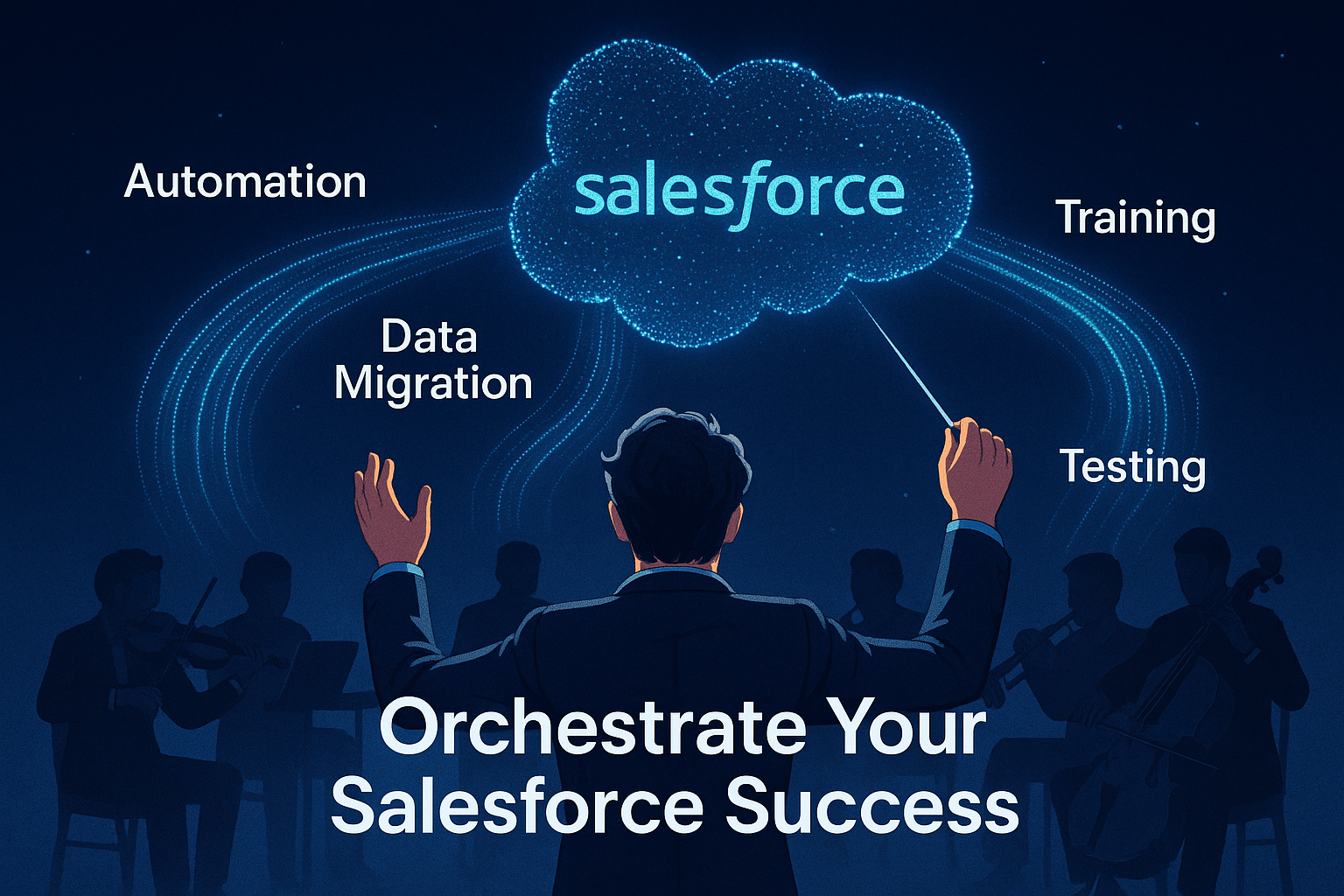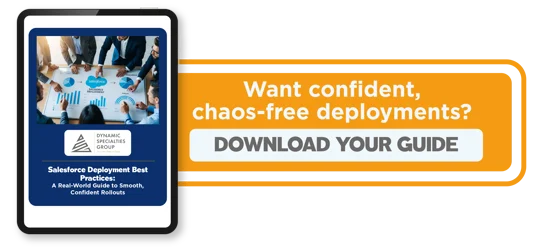Rolling out Salesforce? Excellent choice.
But let’s be honest, success doesn’t just happen when you hit “Activate.”
A smooth Salesforce deployment takes planning, teamwork, and a healthy respect for both data and humans (because one will break if you don’t handle the other carefully).
Let’s talk about what actually makes a Salesforce rollout successful, and how to make it work for your business, your people, and your future self.
7 Factors That Influence Whether Salesforce Deployment Strategies Are Successful (Or Not)
From aligning Salesforce with real business goals to getting serious about data migration, sandboxes, and CI/CD, here are seven factors that can make or break your Salesforce deployment strategy.
- Align Salesforce with business goals
- Determine who belongs on your Salesforce deployment squad
- Treat data migration like a big deal
- Using Salesforce sandboxes as a tool
- Following a proven Salesforce deployment process
- Tracking the technical Salesforce Org details
- Using CI/CD for Salesforce deployments
1. Align Salesforce With Business Goals
Here’s how many Salesforce projects go wrong: someone dives headfirst into creating fields, automations, and reports before asking the most crucial question:
“What are we trying to accomplish with Salesforce?”
Salesforce can do just about anything, but it’s only powerful when it’s designed around your actual business goals.
Trying to shorten your sales cycle? Improve customer retention? Streamline service operations? Your CRM setup should directly support those goals.
When your implementation aligns with business strategy, you stay focused, your build stays relevant, and your team actually uses what you deploy.
Want a deeper look at how to plan this part right? Check out our post, How We Scope a Salesforce Project at DSG (And Why It Actually Works.
2. Determine Who Belongs on Your Salesforce Deployment Squad
The best Salesforce implementations aren’t done to a company—they’re done with it.
Your dream deployment team includes:
- Salesforce-certified experts who understand the platform’s technical backbone.
- Business stakeholders who know what “success” really looks like.
- End users who can tell you what actually happens on the front lines.
And please—don’t skip training. It’s the difference between “we launched Salesforce” and “we love Salesforce.”
When people feel confident, they adopt faster, make fewer errors, and start asking, “What else can Salesforce do for us?”
3. Treat Data Migration Like a Big Deal (Because It Is)
Data migration doesn’t get the glory, but it absolutely makes or breaks your launch.
If your old CRM or spreadsheets are full of duplicates, outdated records, or missing details—guess what? That chaos will follow you into Salesforce.
Before you import a single record:
- Clean and deduplicate your data
- Standardize naming conventions
- Archive or validate what you truly need
Then, choose the correct migration tools:
- For small, simple imports: Salesforce Data Loader or Data Import Wizard
- For large or complex jobs: ETL tools like MuleSoft, Informatica, or Jitterbit
And here’s the pro move: always test your migration in a sandbox first. Validate relationships, run reports, and confirm everything lands where it should.
If you’re prepping your org for migration, see our companion post, When Was the Last Time Your Salesforce Org Got a Health Check?
4. Using Salesforce Sandboxes as a Tool
Think of sandboxes as rehearsal spaces for your Salesforce org—places where you can build, test, and experiment safely.
Here’s the quick breakdown:
- Developer / Developer Pro: For metadata builds and smaller configuration work (no production data).
- Partial Copy Sandbox: A slice of real production data for testing realistic scenarios.
- Full Copy Sandbox: A complete mirror of production—perfect for end-to-end testing and user acceptance.
Note: refresh intervals vary. Developer sandboxes can be refreshed daily; Full sandboxes are typically refreshed every 29 days.
Use them wisely. Build and break things in sandboxes, not in Production. Your admins—and your users—will thank you.
5. Following a Proven Salesforce Deployment Process (Not a Hunch)
A Salesforce deployment isn’t one big push—it’s a series of smart, repeatable steps.
Here’s the DSG-approved roadmap:
- Discovery – Map out your business processes (seriously, flowcharts save lives).
- Planning & Design – Define outcomes, data structures, and automation logic.
- Development – Build and configure in your sandbox.
- Testing – Run functional tests and Apex code tests until you’re confident.
- User Acceptance Testing (UAT) – Let real users validate your work.
- Pre-Production Checks – Finalize your deployment plan, backups, and dependencies.
- Go Live – Push to production and monitor carefully.
For smaller orgs, Change Sets can handle simple deployments—but they have limitations (some metadata types aren’t supported, dependencies must be added manually, and there’s no rollback).
For larger projects, tools like Salesforce DX, CLI, or Copado Essentials Plus automate testing, manage dependencies, and reduce risk.
If you’re thinking DevOps is overkill, you’ll love our post Let’s Talk DevOps and CI/CD for Salesforce: Why It’s a Game Changer (Especially Now).
6. Tracking the Technical Salesforce Org Details
Behind every stable Salesforce org is someone who took version control seriously.Using GitHub, Copado, or Gearset helps teams track every change, roll back safely, and collaborate cleanly.
And backups? They’re not optional. Salesforce doesn’t automatically back up metadata, so use OwnBackup, Spanning, or the Metadata API to secure both data and configuration.
Keep an eye on dependencies—some components rely on others (for example, a validation rule referencing a field that hasn't been deployed yet). Document and deploy in logical order. It’s not glamorous, but it’s how you avoid “mystery errors” on launch day.
7. Using CI/CD for Salesforce Deployments
If your org is scaling fast, Continuous Integration and Continuous Deployment (CI/CD) is your best friend.
Tools like Copado, GitHub Actions, Jenkins, or Azure DevOps let you automatically test and deploy in small, manageable chunks—reducing human error and keeping your environments in sync.
Salesforce requires 75% Apex code coverage to push code into production, but don’t stop there. Actually test real-world scenarios, not just happy paths.
And always—always—have a rollback plan.
Salesforce doesn’t have an “undo” button. Keep your last known-good version in source control and back up metadata before every major release.
Striving for Long-Term Success with Salesforce Deployment Strategies
You can build the world’s best Salesforce org—but if your users don’t love it, it won’t stick.CRM adoption starts with understanding, continues with support, and thrives on continuous improvement.
Give users the tools they need:
- Live training sessions (with recordings for reference)
- Quick guides and videos
- In-app help with Salesforce In-App Guidance
After launch, keep the feedback loop alive. Run surveys, monitor dashboards, and track adoption through Salesforce Enablement Manager.
When users struggle, tweak and refine. Salesforce is built to evolve—so should your implementation.
Need inspiration on keeping things lean and scalable? Check out Is It Better to Configure or Customize Your Salesforce Org?
And please, protect your data.
The DSG Takeaway: A Smart Salesforce Deployment Is a Team Sport
A successful Salesforce deployment isn’t just about technology—it’s about teamwork, planning, and continuous improvement.
When you start with strategy, align your people, protect your data, and invest in adoption—you don’t just launch Salesforce. You leverage it.
At Dynamic Specialties Group, we guide teams through every phase of Salesforce deployment with practical strategy, clean data, and a bit of wit along the way.
Because a great Salesforce rollout isn’t a finish line—it’s the start of better business.







SHARE